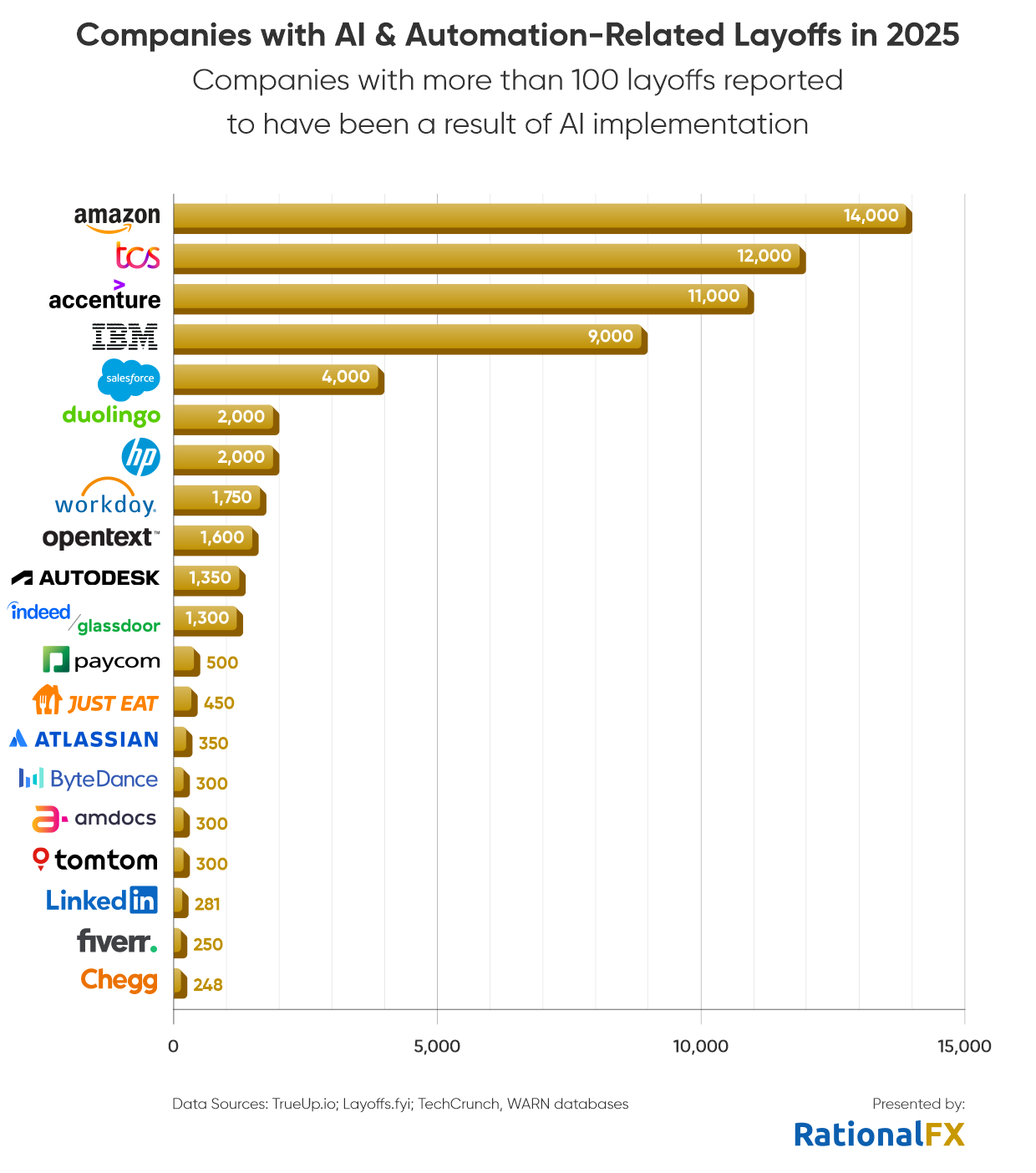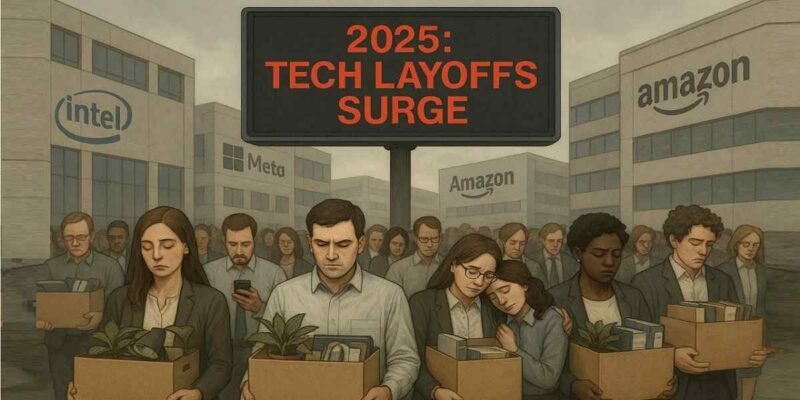When Amazon confirmed plans this week to lay off 14,000 corporate employees, it added another chapter to one of the tech industry’s toughest years. According to a new report by RationalFX, a global forex and financial insights platform, over 202,000 workers in the tech sector have lost their jobs so far in 2025, with projections hitting 244,000 by year-end.
Since its 2024 acquisition by Markets Chain Limited, RationalFX has leveraged its financial expertise to become a global market intelligence hub, tracking workforce trends, investment shifts, and economic volatility that impact industries such as tech.
The report by the platform indicates that nearly 70% of these job losses, or approximately 140,000 positions, originated from U.S.-based companies such as Intel, Microsoft, and Amazon. It also revealed that at least 64,000 of the layoffs are directly linked to automation and the growing use of artificial intelligence in corporate operations.
For many workers, these figures show how the rise of AI is transforming the tech industry faster than expected. Companies are restructuring to become leaner, relying on software and automation tools that can perform repetitive or administrative tasks once handled by humans.
According to RationalFX, the 10 companies with the largest layoffs in 2025 include Intel (33,900), Amazon (19,555), Microsoft (19,215), TCS (12,000), and Accenture (11,000). Others on the list are Panasonic, IBM, Salesforce, STMicroelectronics, and Meta. Together, these firms account for a large share of the ongoing workforce reductions reshaping the global tech landscape.

Amazon’s latest cuts tied to AI and “efficiency”
In a memo to employees, Beth Galetti, Amazon’s Senior Vice President of People Experience and Technology, said the layoffs are part of a larger effort to make the company “leaner” and more adaptable in what she called “the most transformative technology era since the Internet.”
She explained that while the company continues to perform well financially, it must reorganise to move faster and stay competitive in AI and cloud services. The changes will affect several teams globally, though Amazon said it will continue hiring in key strategic areas even as it reduces corporate layers elsewhere.
The memo also stated that affected employees will receive 90 days to seek internal roles and will be offered severance pay and transition support if they cannot be retained.
This marks one of Amazon’s largest layoffs since 2023, when the company eliminated 27,000 roles amid slowing e-commerce demand. But this time, the reason is different. Amazon says automation and AI will help it operate more efficiently across logistics, retail, and cloud operations, allowing fewer people to manage bigger systems.
RationalFX’s report notes that Amazon is not alone. Other major tech firms like Microsoft, Accenture, and IBM are making similar moves. Many are investing heavily in AI development while cutting back on administrative or customer-support roles now handled by automation tools.
A global shift driven by automation
The U.S. continues to experience the most tech layoffs globally, representing approximately 70% of this year’s total, with Intel reducing its workforce by 31% and Microsoft laying off roughly 19,000 employees.
In India, Tata Consultancy Services (TCS) has announced 12,000 job cuts as part of a restructuring plan that prepares the company for more AI-powered operations. Japan’s Panasonic is also reducing 10,000 roles to cut costs and improve profitability.


Meanwhile, European tech firms such as STMicroelectronics and Northvolt are also facing financial pressure. Northvolt, a Swedish battery maker, filed for bankruptcy earlier this year, leading to over 3,000 layoffs.
According to Alan Cohen, Analyst at RationalFX, the 2025 layoffs signal “a rebalancing of the workforce” rather than a total replacement of humans by machines. He explained that most companies are using automation to handle functions such as administration, data entry, and some engineering tasks, areas where machines can deliver faster, cheaper results.
Also read: Amazon to cut at least 30,000 corporate jobs in its biggest layoffs yet
Cohen added that while the transition is painful, it is also pushing companies to rethink how work is done. “Some businesses are still struggling to adapt, but others are moving fast, transforming not just their teams but their entire operations. Their motto is simple: whoever adapts the fastest will win,” he said.
Why this matters: the road ahead for corporate organisations and employees
Layoffs in the tech industry highlight its evolving structure. Despite strong profits and increased revenue, many companies are reducing their workforce. For example, Microsoft reported over $76 billion in revenue for the quarter ending June 2025, an 18% increase year-over-year, even while cutting thousands of jobs.
These layoffs reflect a strategic shift towards efficiency and reinvention, driven by AI investments aimed at gaining a competitive edge, often resulting in the displacement of traditional roles.


For workers, it reflects the need to reskill quickly to stay relevant in an AI-driven economy. Many roles in marketing, support, and operations are being replaced or redesigned around AI systems.
This trend raises critical questions for investors and policymakers: Can economies adapt to automation quickly enough to avoid increased unemployment? And how can businesses reconcile profit with the needs of their workforce?
If RationalFX’s projection proves accurate, the tech industry could see nearly a quarter of a million job losses by the end of 2025, the highest annual total since the post-pandemic corrections in 2022 and 2023.








